
The Ultimate Guide to Lifecycle Emails for SaaS in 2024

par
Wiktoria Slowikowska
3 oct. 2024
Identifiez et convertissez vos utilisateurs les plus importants
Créer un compte
Keeping users engaged and ensuring they stick around for the long haul is key to success. Sure, acquiring new customers is important, but it's the ones you keep and nurture who truly drive your business forward. This is where lifecycle emails come into play.
Lifecycle emails are automated, behavior-based emails designed to guide customers through different stages of their journey with your product. These emails can cover everything from acquisition and onboarding to ongoing engagement, retention, and even advocacy. Done right, they’re one of the most powerful tools you have to build strong, lasting relationships with your users.
In this guide, we’ll break down why lifecycle emails are so important for SaaS companies, explain the different types, and offer tips to help you create an effective email strategy.
But here's the key: to send the right lifecycle emails, you need to know exactly where each user is in their journey. Understanding their current stage lets you send emails that feel personal, relevant, and timely—giving your users exactly what they need, when they need it.

Why Lifecycle Emails Matter for SaaS
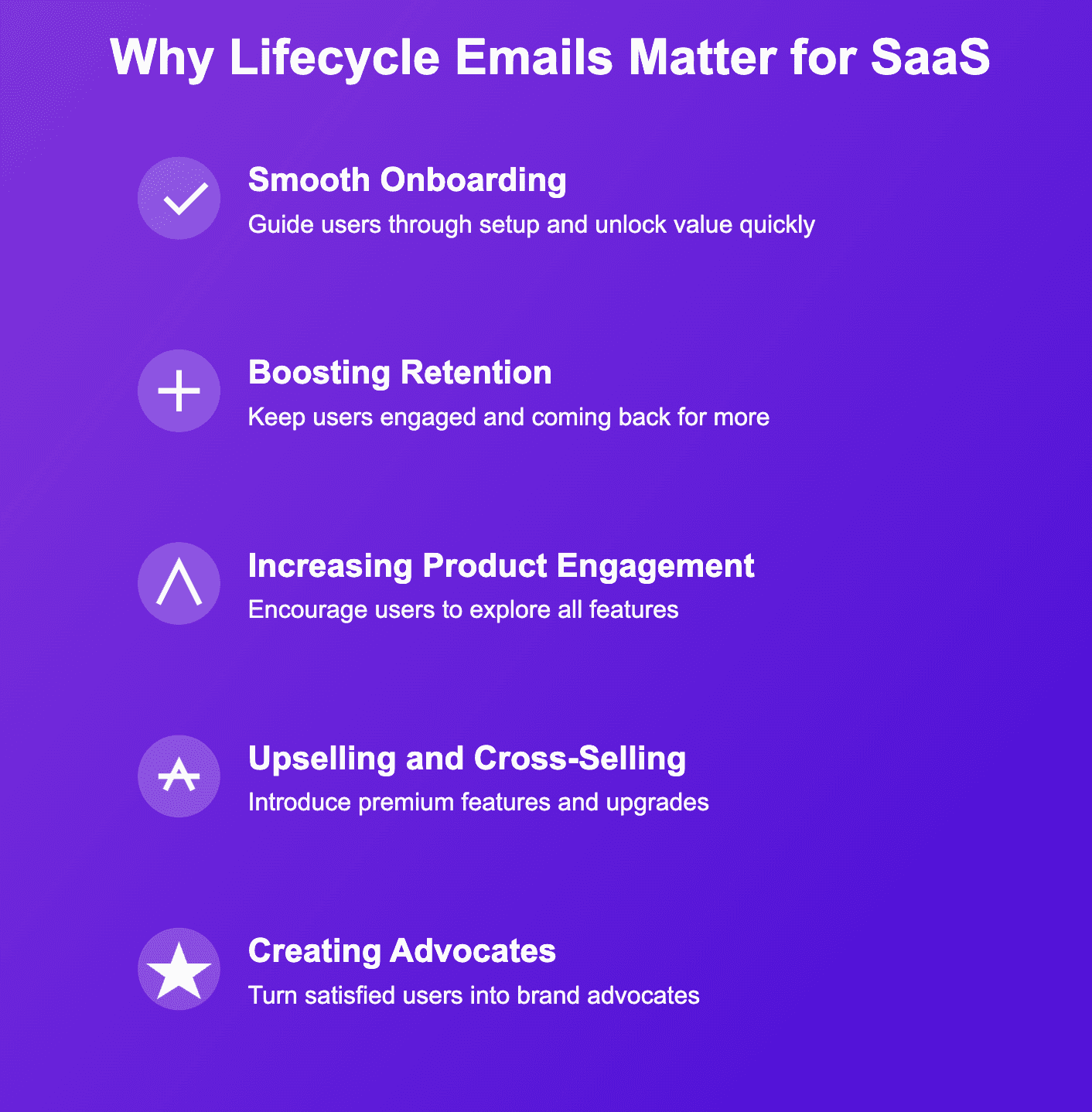
Before jumping into the nuts and bolts, let’s talk about why lifecycle emails are such a big deal for SaaS businesses.
Smooth Onboarding: A smooth onboarding process is essential. If users don’t get value quickly, they’re likely to drop off. Lifecycle emails can guide them through the setup and help them unlock your product’s value fast.
Boosting Retention: Retaining a customer is far more cost-effective than constantly trying to acquire new ones. By sending the right emails at the right times, you can keep users engaged and coming back for more.
Increasing Product Engagement: Many users don’t explore all of your product’s features, which means they might not fully experience its value. Lifecycle emails can encourage users to try out those lesser-known features, increasing their overall engagement.
Upselling and Cross-Selling: Once a customer sees value in your product, lifecycle emails can introduce them to premium features, upgrades, or complementary services, increasing the chances of upsells.
Creating Advocates: Happy customers are more likely to recommend your product to others. Lifecycle emails can nurture those relationships, turning satisfied users into brand advocates.
However, for these emails to work effectively, you must know where your users are in their lifecycle—whether they’re a brand-new user who just signed up, a loyal customer who’s been with you for a while, or someone at risk of churning. Each stage requires a different approach.
Understanding the SaaS Customer Lifecycle

In a SaaS business, your users go through various stages in their relationship with your product. Each stage has its own challenges and opportunities, which makes sending the right emails at the right time crucial.
Let’s break down the different lifecycle stages:
Acquisition: This is the initial phase where someone shows interest in your product but hasn't signed up yet.
Goal: Turn these leads into actual sign-ups by showcasing the value of your product and how it can solve their problems.
Onboarding: After signing up, new users need to be guided through setting up and using your product. Without proper guidance, they could get frustrated and leave.
Goal: Help users complete their initial setup, explore key features, and understand how to use your product effectively.
Engagement: Once a user has successfully onboarded, the focus shifts to keeping them actively engaged. This means encouraging them to explore more features and deepen their usage of your product.
Goal: Prevent users from disengaging by continually offering value and ensuring they’re getting the most out of your product.
Retention: Users who stop using your product regularly are at risk of churning. This stage is all about bringing them back before they cancel their subscription.
Goal: Remind users of the value your product brings and encourage them to stay.
Advocacy: Satisfied users are your best marketers. They can recommend your product to others, leave positive reviews, or even become part of referral programs.
Goal: Turn happy users into advocates by making it easy for them to share their positive experiences or refer others to your platform.
Types of Lifecycle Emails for SaaS
Now that we know the stages, let's go over the specific types of emails you’ll want to use to target users at each stage of their lifecycle. Each email should feel relevant and personal to where the user is in their journey.
1. Welcome Emails
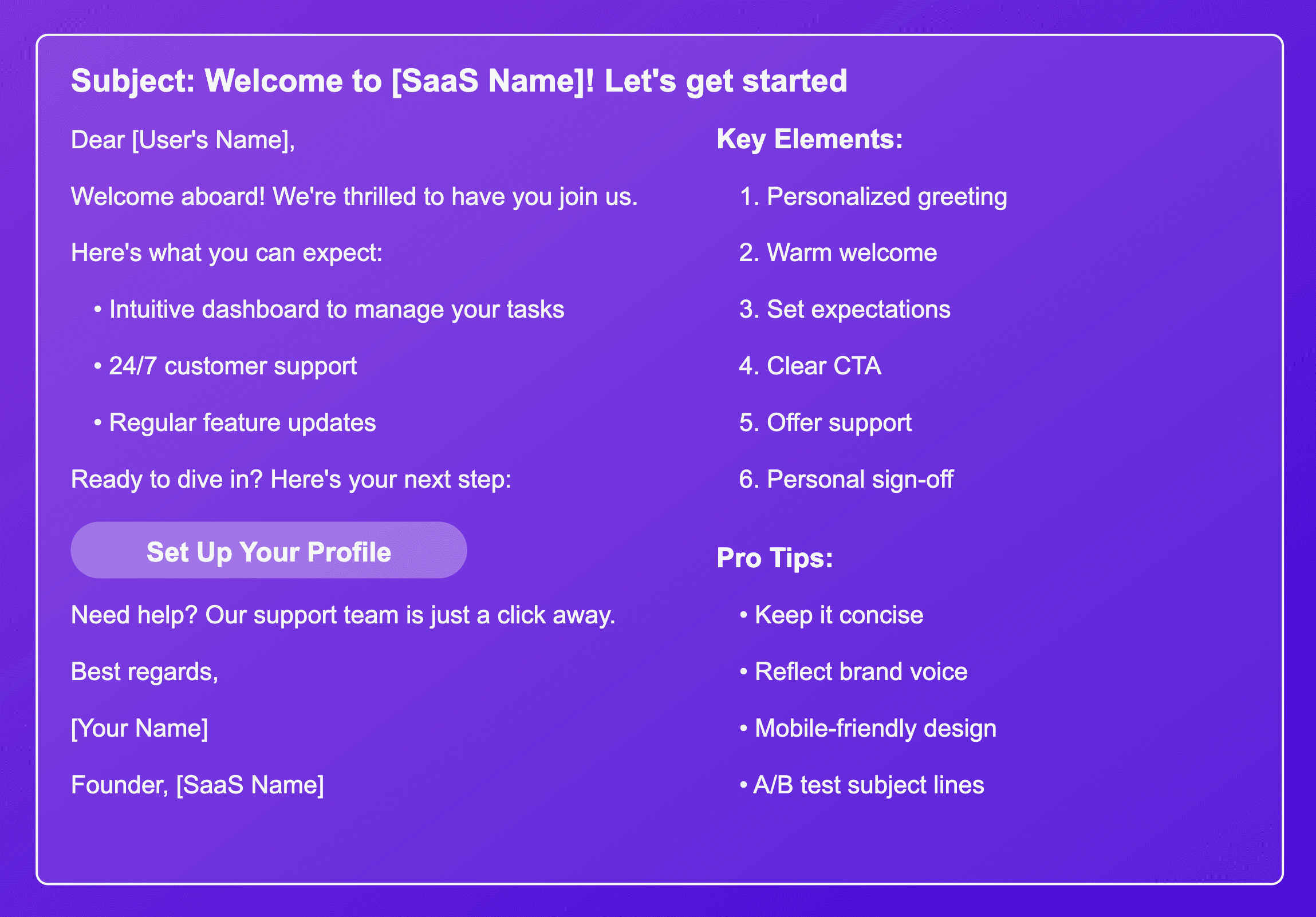
These are the first emails your new users receive after signing up. They set the tone for your relationship and provide a first impression of your brand.
Purpose: Welcome the user, thank them for signing up, and guide them through the next steps.
Tip: Personalize the welcome by using their name and highlighting what comes next, like setting up their account or exploring the dashboard.
2. Onboarding Emails
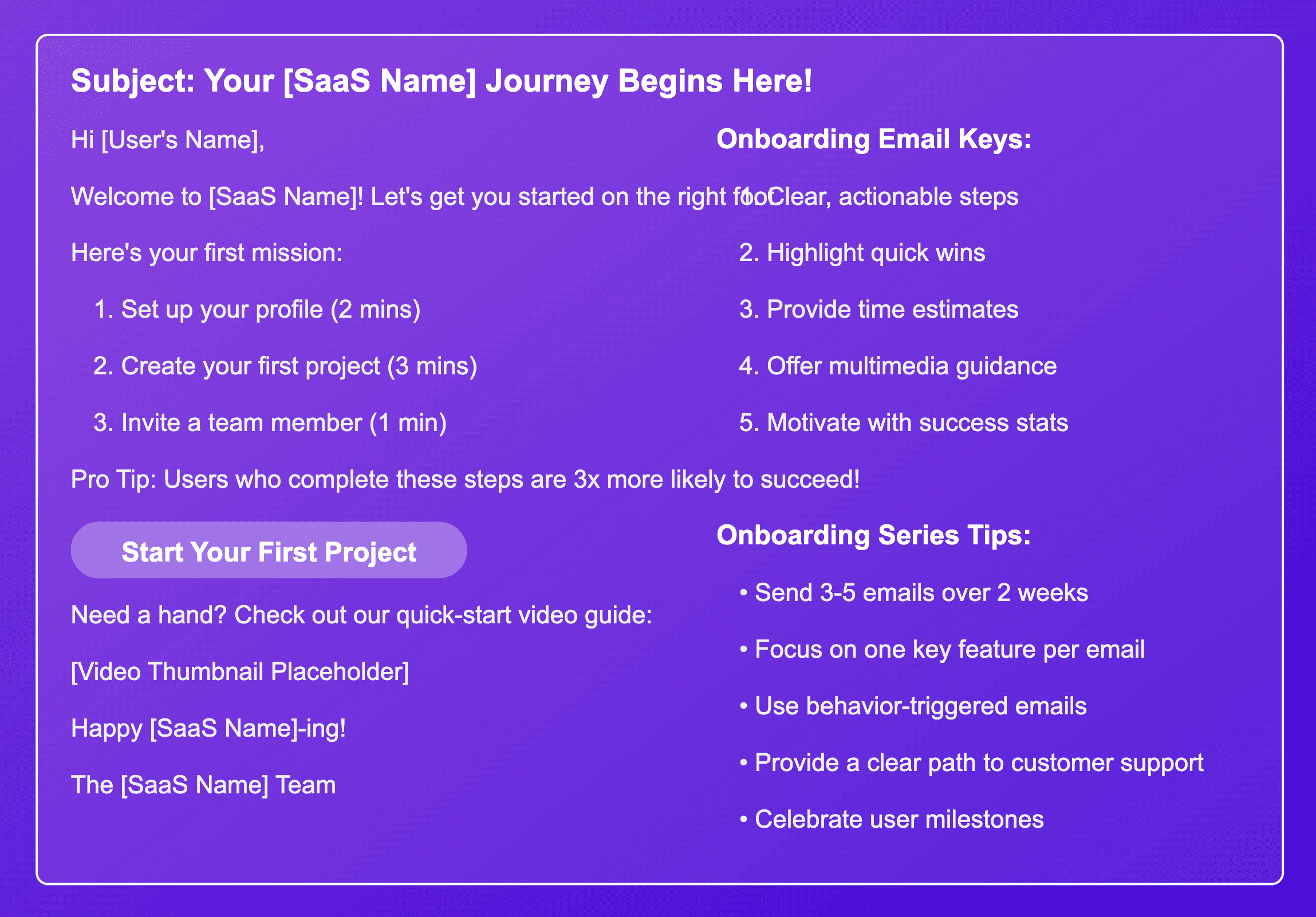
Onboarding emails are like a tour guide for your new users. The goal is to make them comfortable with your product and get them to experience its value as quickly as possible.
Purpose: Provide step-by-step guidance, showcase key features, and offer tips for getting started.
Tip: Break onboarding into manageable chunks and highlight small wins, like setting up their first project or completing a profile.
3. Activation Emails
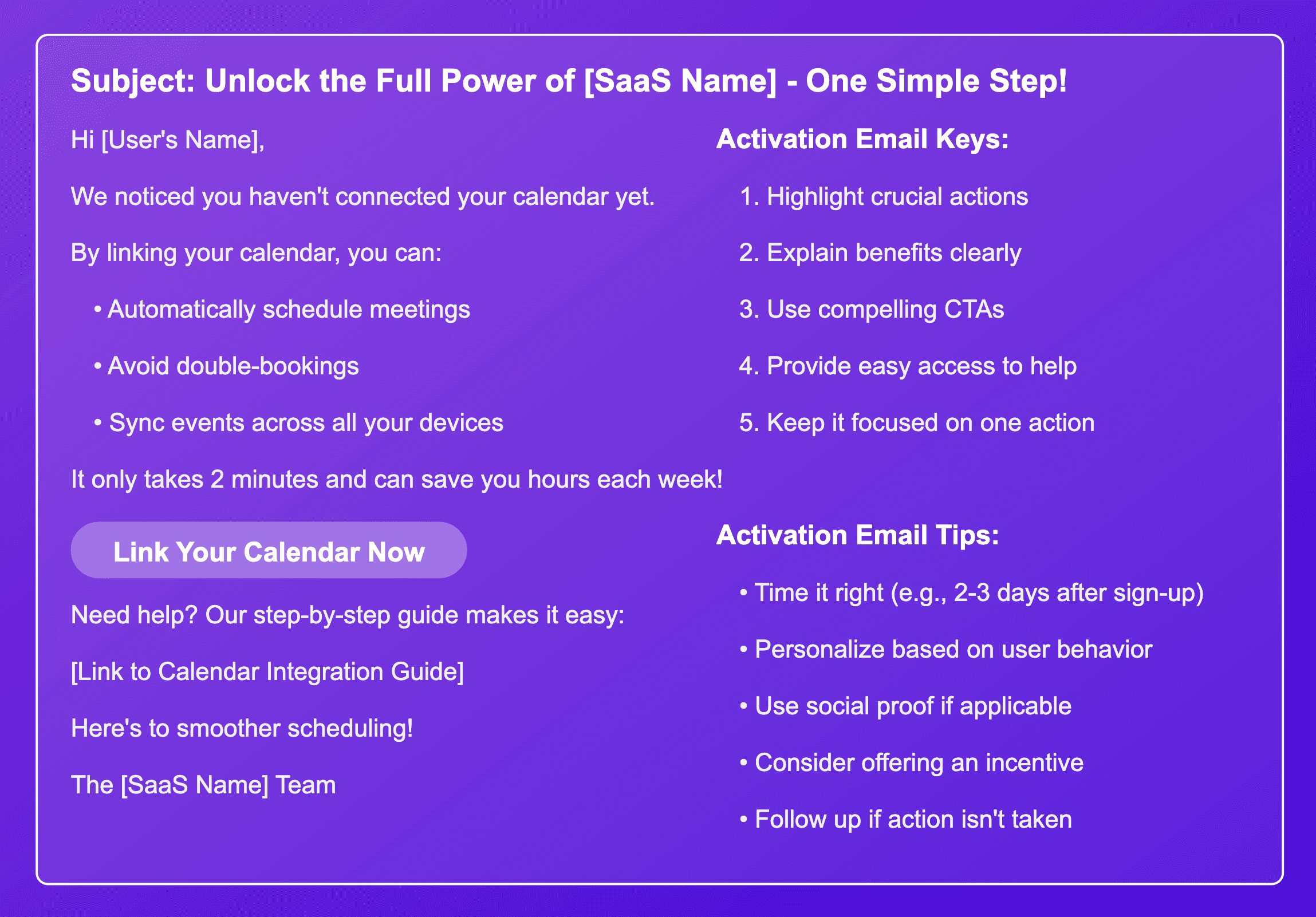
Activation emails help ensure that users take crucial actions that will unlock the full value of your product. These actions are often key to your user’s long-term engagement.
Purpose: Encourage users to complete essential steps, like connecting an integration, setting preferences, or customizing their account.
Tip: Use clear CTAs and remind them of the benefits of these actions. For example, “Link your calendar to streamline your scheduling.”
4. Engagement Emails

These emails are sent to users who have been onboarded but may not be using your product to its full potential. Engagement emails can drive feature discovery, usage, and habit-building.
Purpose: Encourage users to explore underused features, attend a webinar, or dive deeper into your product.
Tip: Personalize these emails based on actual usage data. For example, if a user hasn’t tried a powerful feature, show them how it could benefit them.
5. Re-Engagement Emails
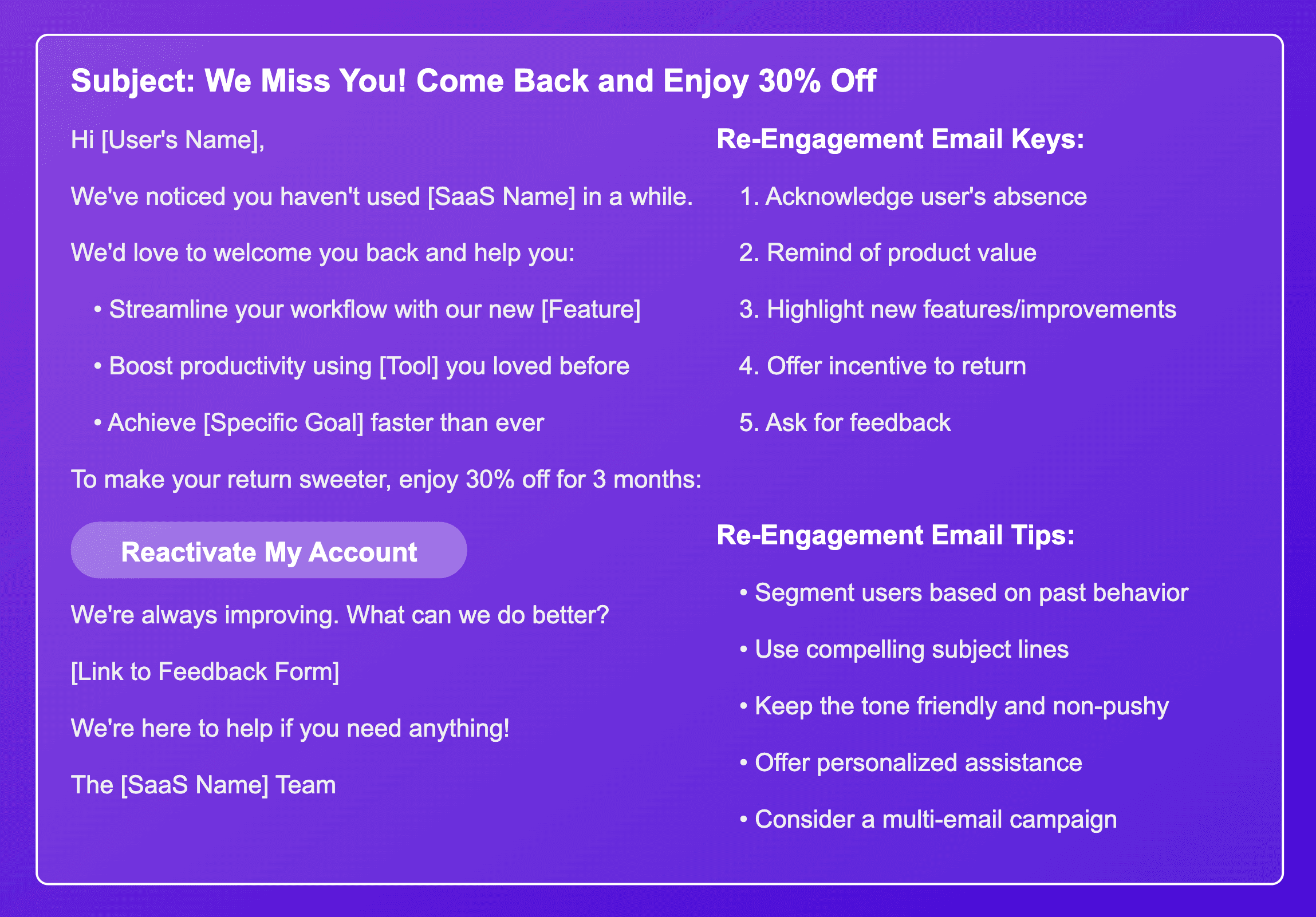
When users start to drift away, re-engagement emails can pull them back in. These are sent when users stop interacting with your product or are at risk of churning.
Purpose: Remind users of your product’s value and offer incentives to return, like special discounts or personalized help.
Tip: Address the reasons for their disengagement, and if possible, include a feedback loop (e.g., “What can we do better?”).
6. Product Update Emails
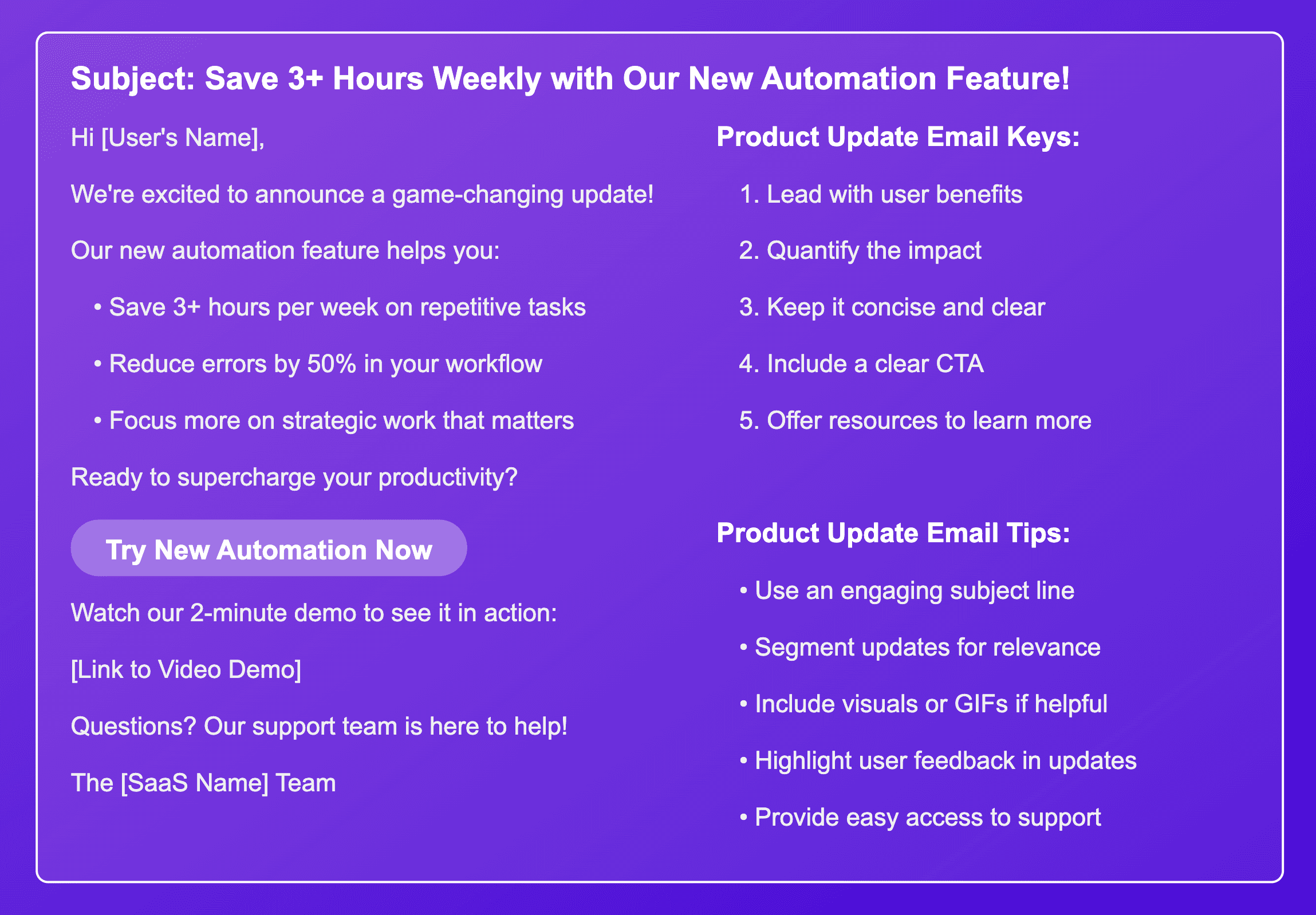
As your product evolves, keep users in the loop about new features, improvements, or important updates. These emails can also be used to reignite interest in disengaged users.
Purpose: Inform users of product changes and how they can benefit from them.
Tip: Frame the update in terms of user benefit, not just a feature dump. For instance, “You can now save even more time with our new automation feature.”
7. Retention Emails
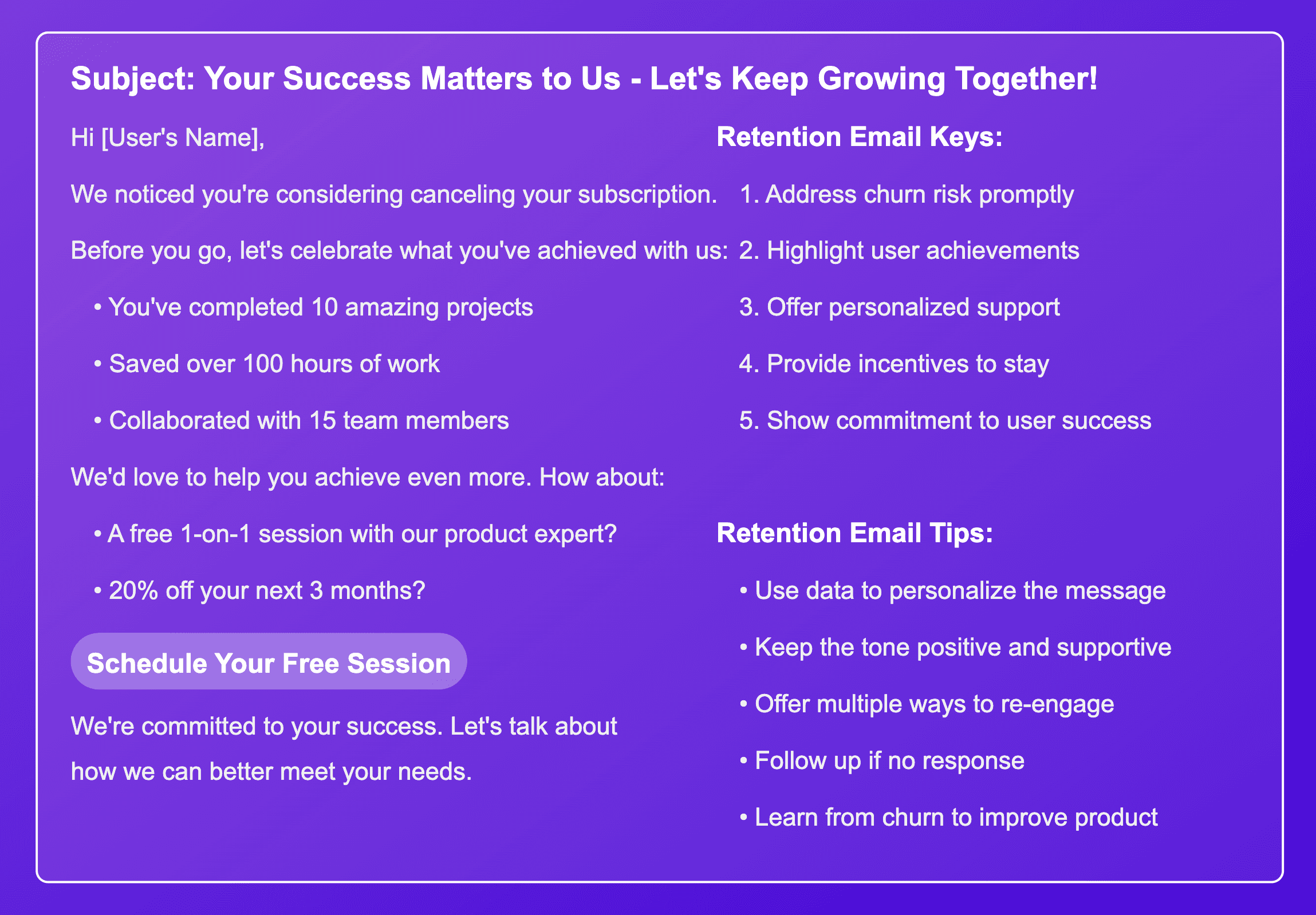
If a user shows signs of canceling or churning, retention emails can be your last attempt to keep them on board.
Purpose: Provide personalized support, address pain points, or offer incentives to stay.
Tip: Use these emails to highlight the user’s journey so far (e.g., “You’ve completed 10 projects with us!”) and show how much more they could achieve.
8. Upsell and Cross-Sell Emails

Once users are comfortable with your product, you can introduce them to premium features, higher-tier plans, or complementary services that fit their needs.
Purpose: Increase the customer’s lifetime value by offering relevant upgrades or additional services.
Tip: Personalize these offers based on how they use the product. If a user frequently uses a particular feature, show them how upgrading could enhance their experience.
9. Advocacy and Referral Emails
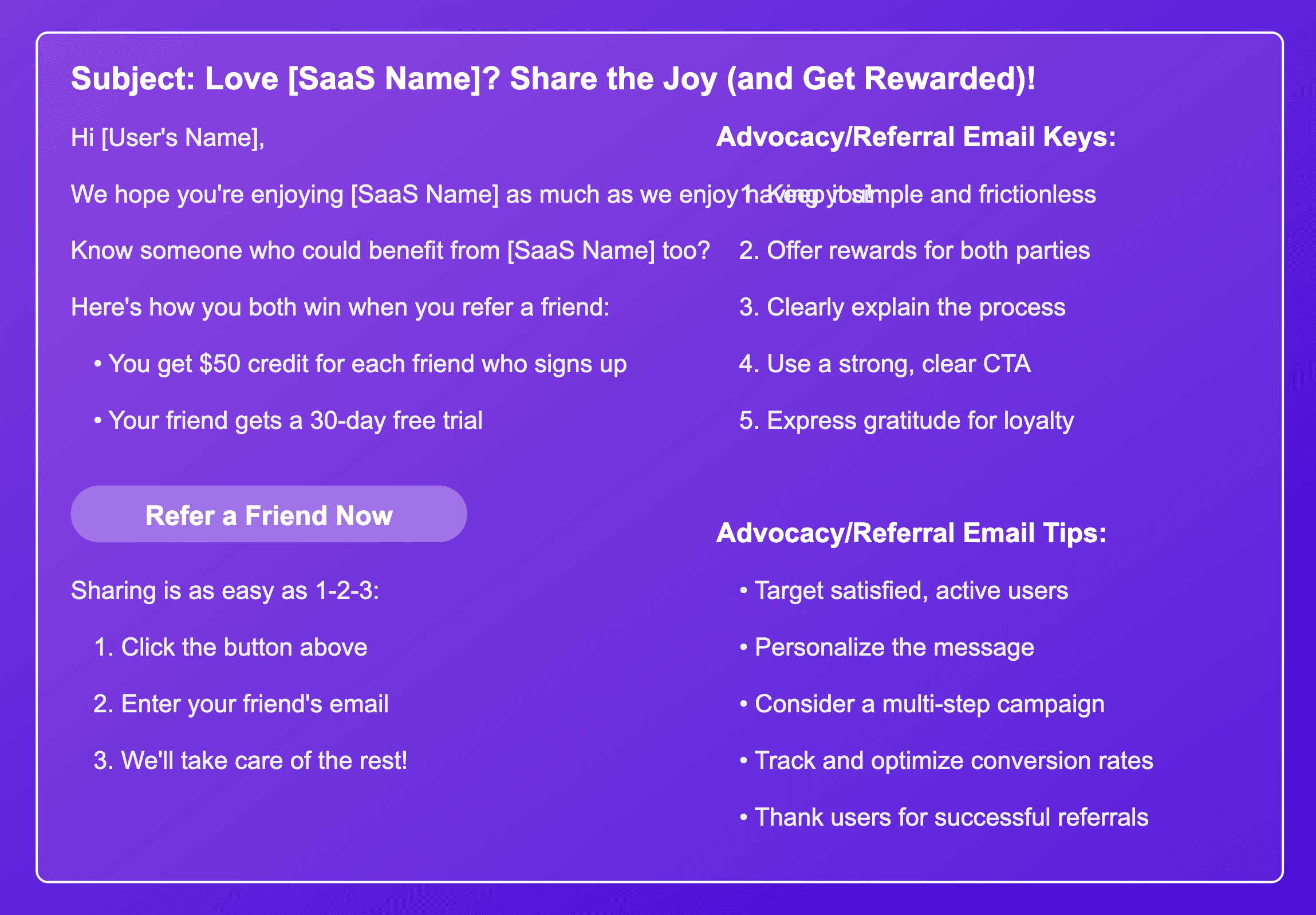
Finally, advocacy emails encourage happy customers to spread the word about your product or share their positive experience.
Purpose: Encourage referrals, reviews, or social sharing.
Tip: Make it easy to refer friends by offering rewards for both the referrer and the new user. Keep the process simple and frictionless.
At the end of the article, we’ll explore some realworld good examples to help you implement these strategies effectively, so keep reading!
How to Make Lifecycle Emails Work for You

Sending lifecycle emails isn’t just about writing clever copy. For these emails to be effective, you need to have a deep understanding of where your users are in their journey with your product. This means tracking user behavior, segmenting your audience, and automating emails based on specific triggers.
1. Know Your User’s Stage
Use data to figure out where each user is in the lifecycle. Have they just signed up, or are they showing signs of churning? This insight will help you deliver the right message at the right time.
2. Personalization is Key
Tailor each email to reflect the user’s specific situation. The more personalized the content feels, the better the results. Use their name, refer to their specific use case, and mention their past interactions.
3. Automation for Timeliness
Leverage automation tools to ensure your emails reach users at exactly the right moment. Whether it’s after they complete a task or go inactive, sending emails based on user actions creates a more seamless experience.
4. Value First
Always focus on delivering value. Whether you’re introducing a feature or trying to prevent churn, make sure the user sees how your product is making their life easier or solving their problems.
Examples of Lifecycle Emails:
1. Welcome Email
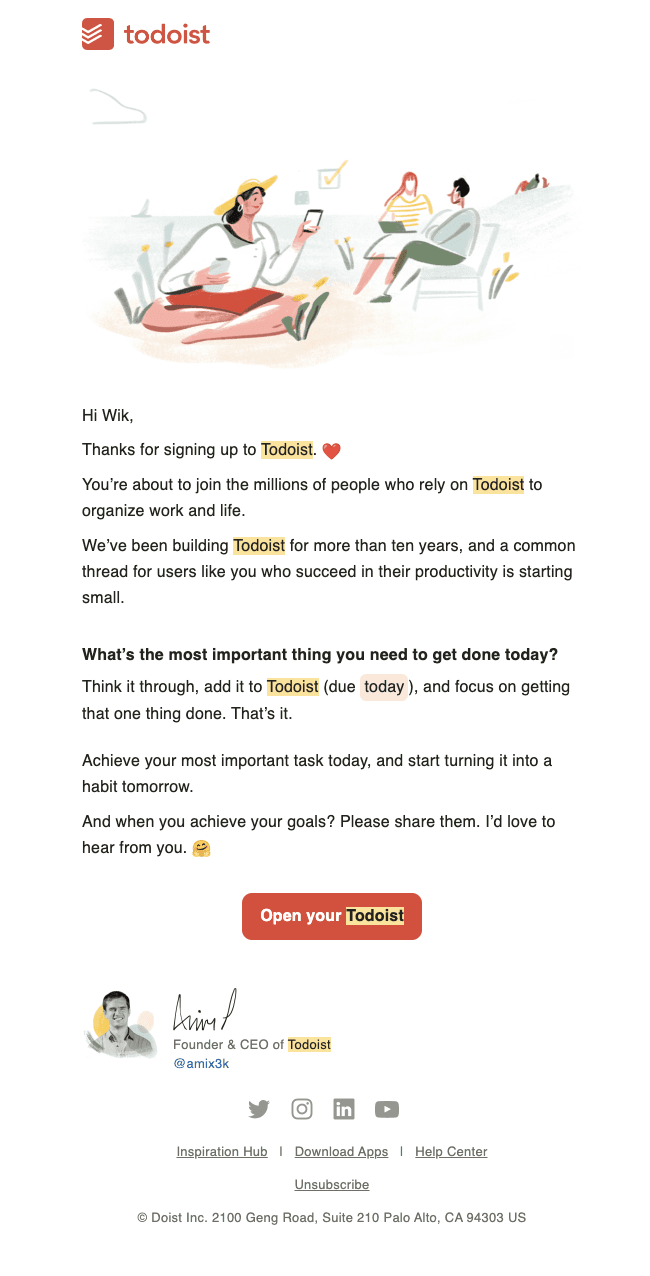
This welcome email from Todoist effectively introduces new users to the app's core purpose of organizing work and life, highlighting its long-standing history and large user base to build credibility.
The email engages users immediately by prompting them to identify and add their most important task for the day, encouraging immediate action and demonstrating the app's simplicity.
Personal touches, such as addressing the user by name, including a message from the founder, and inviting users to share their achievements, create a sense of community and foster a connection between the user and the Todoist team.
2. Activation Email
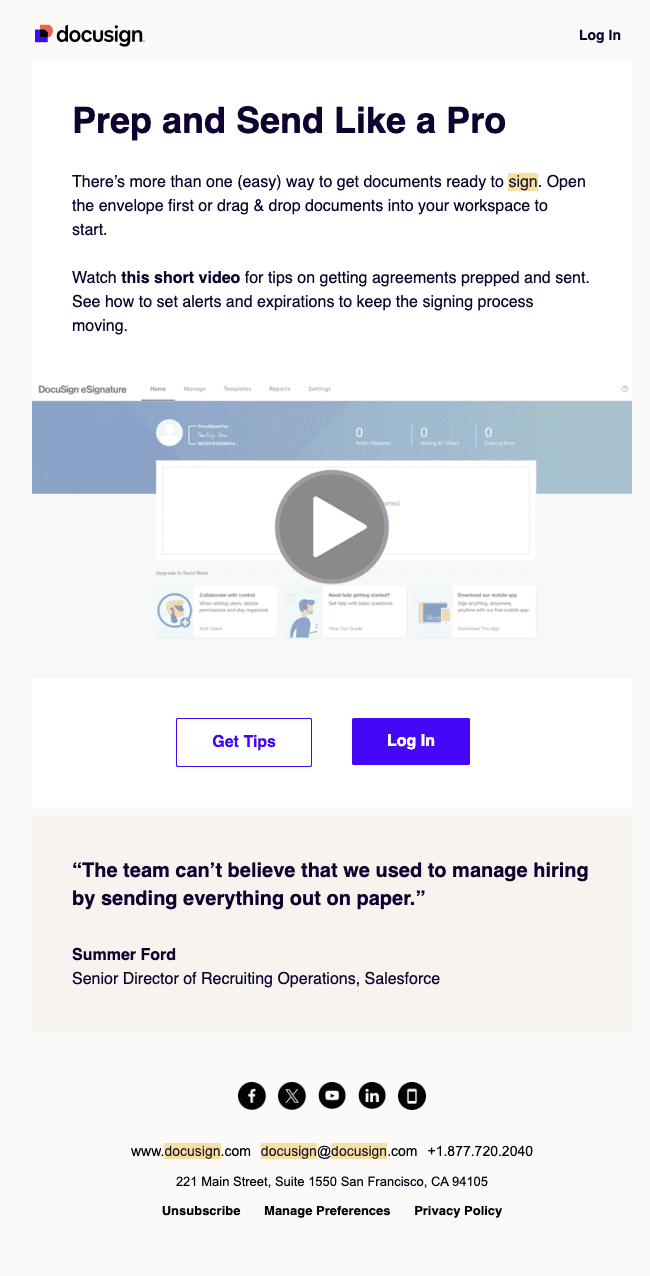
The email focuses on getting new users to take their first meaningful actions with DocuSign, providing simple instructions and a video tutorial to guide them through preparing and sending documents.
It employs a mix of educational content and action-oriented elements, including the "Get Tips" and "Log In" buttons, to encourage immediate platform engagement and overcome potential hesitation.
The inclusion of a customer testimonial highlighting the transformative impact of DocuSign serves to motivate new users by showcasing the platform's value, potentially increasing their likelihood of becoming active users.
3. Re-Engagement Email
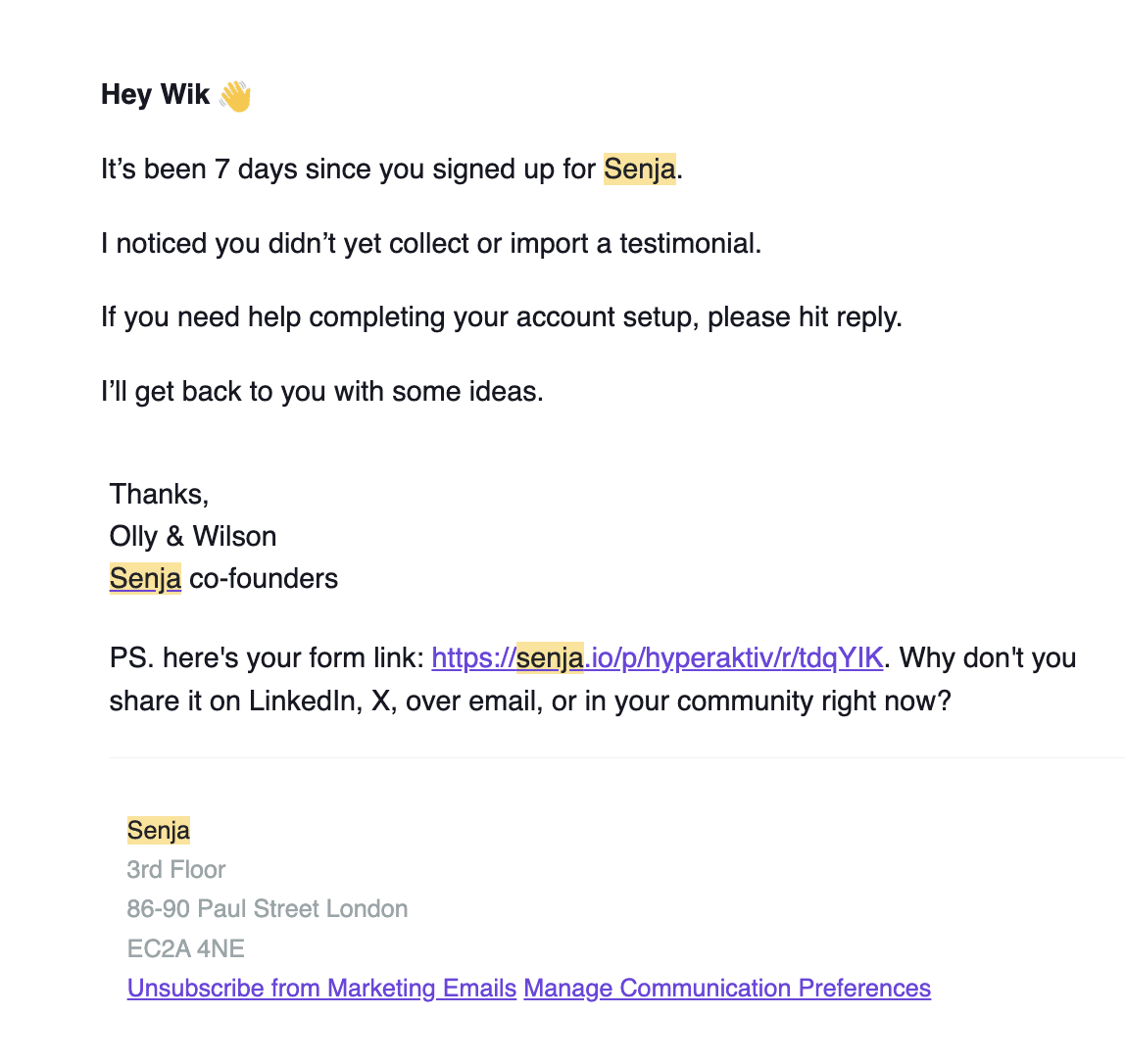
The email targets a user who signed up 7 days ago but hasn't completed a key action (collecting or importing a testimonial), indicating an attempt to re-engage a potentially disengaged user.
It offers personalized assistance to help the user complete their account setup, showing a proactive approach to overcoming potential obstacles that may have caused the user's inactivity.
The email includes a direct call-to-action with a form link and suggestions for sharing, aiming to prompt immediate engagement and reactivate the user's interest in the platform.
Final Thoughts
Lifecycle emails are a game-changer for SaaS companies, offering a way to stay connected with your users at every stage of their journey. By understanding where users are in their lifecycle and sending the right message at the right time, you can increase engagement, boost retention, and turn happy customers into advocates.




